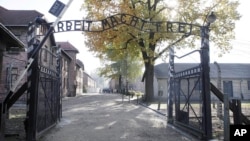A new exhibition in southern Poland shows the brutality of the Nazi German death camp of Auschwitz through the artistic work of its inmates. Some of the artworks are being shown publicly for the first time.
The "Face to Face: Art in Auschwitz" exhibition opened last week at the Kamienica Szolayskich (Szolayski Tenement House) of the National Museum in Krakow to mark 70 years of the Auschwitz Museum. The museum's task is to preserve the site in the southern town of Oswiecim and to educate visitors about it. More than 2 million people visited the museum last year.
The curator of the Krakow exhibit, Agnieszka Sieradzka, said Wednesday it includes clandestine as well as commissioned drawings and paintings by Jews, Poles and other citizens held at Auschwitz during World War II.
"These works help us see Auschwitz as the inmates saw it and experienced it," Sieradzka told The Associated Press. "We stand face to face with the inmates."
The Nazis sometimes ordered talented inmates to make paintings for various purposes. One such painting is a portrait of a Roma woman that pseudo-scientist Josef Mengele experimented on. Mengele ordered portraits like this from inmate painter Dina Gottliebova, a Jewish woman from Czechoslovakia.
The task helped Gottliebova survive. After the war, she traveled to the U.S. and started a family. She died in 2009 in California under the name Dina Babbitt.
Among the clandestine art is the so-called Auschwitz Sketchbook by an unknown author. It has 22 drawings of scenes of beatings, starvation and death. It was found in 1947, hidden in a bottle in the foundation of a barrack at Birkenau, a part of the Auschwitz-Birkenau complex. It is the first time it is being shown to the general public. It is housed at the museum and only shown on request.
Also being displayed is the original "Arbeit Macht Frei" (Work Sets You Free) gate top that was stolen and retrieved in 2009 and is now kept under guard at the museum.
From 1940 to 1945, some 1.1 million people, mostly European Jews but also Poles, Roma and Russians, were killed in the gas chambers or died from starvation, excessive forced labor and disease at Auschwitz, which Nazi Germany operated in occupied Poland.








